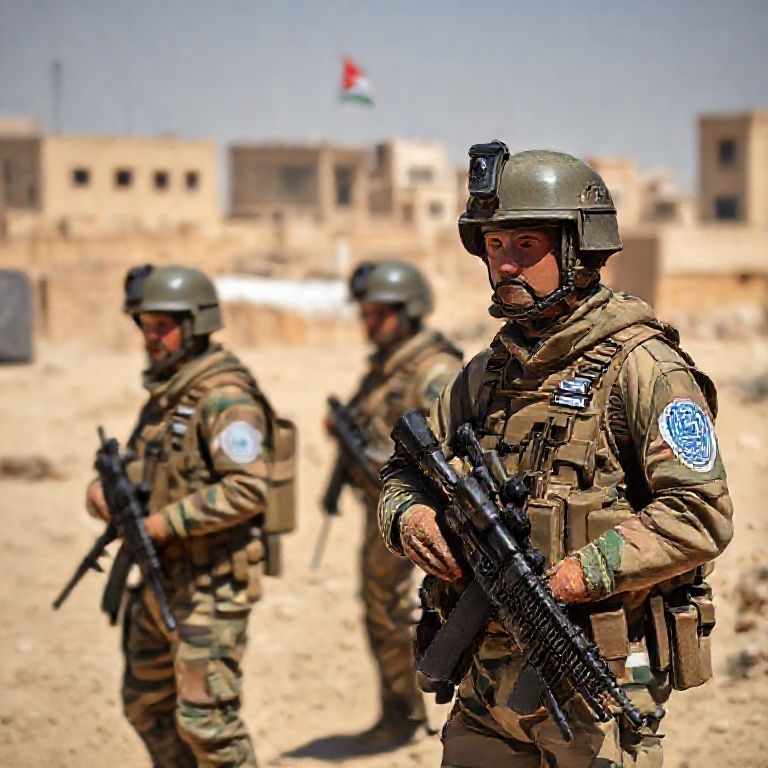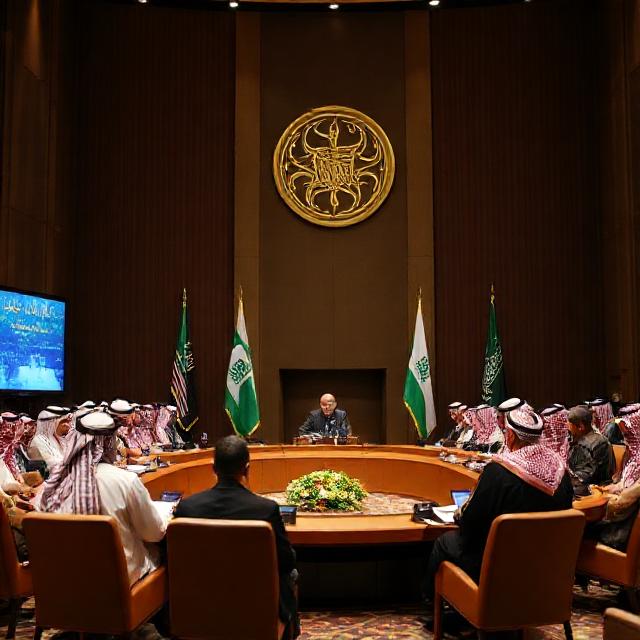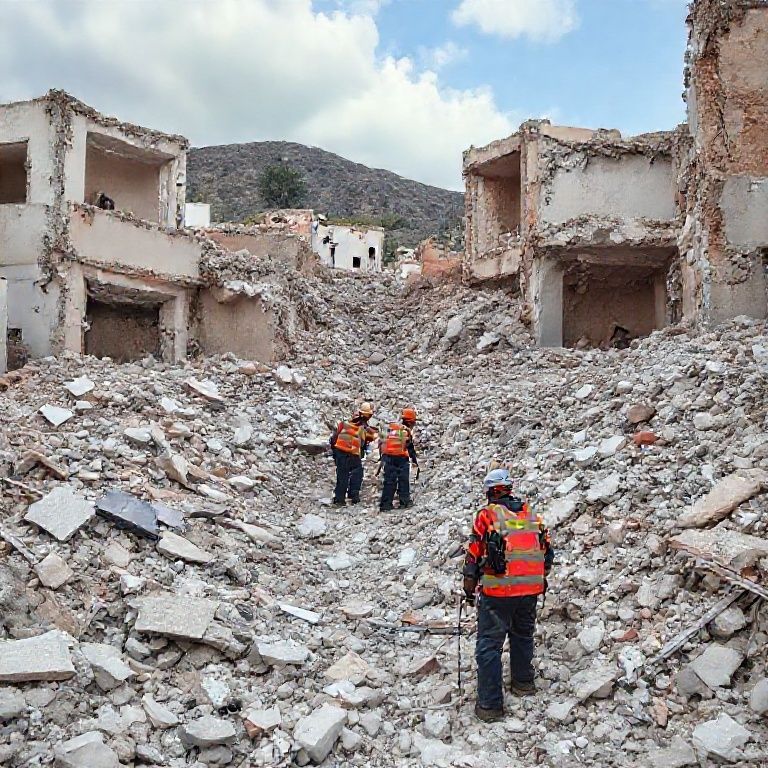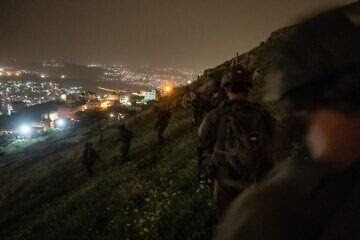Donald Trump has recently been urging Saudi Crown Prince Mohammed bin Salman (MBS) to move toward normalizing relations with Israel following the end of the Gaza war. The push comes ahead of a planned meeting between Trump and the Saudi crown prince at the White House. U.S. officials are optimistic about getting progress on the initiative.
A 5.1-magnitude earthquake struck near Cyprus on November 12, 2025, at approximately 11:31 a.m. local time, with tremors felt across northern Israel, including in cities like Haifa, Afula, and Nazareth. The earthquake’s epicenter was near the city of Paphos in western Cyprus and originated roughly 15-20 kilometers beneath the surface.
“He wishes to ‘liberate from the past and have a noble pursuit for his people and his country and to be a great ally to the United States of America,’” Rep. Brian Mast stated.
(JNS)
Syrian President Ahmed al-Sharaa met with U.S. President Donald Trump on Monday in the first time that a Syrian head of state has visited the White House.
Trump spoke to reporters about the oval office meeting with the Syrian leader later in the day during a swearing-in ceremony for the new U.S. ambassador to India.
“He’s a very strong leader. He comes from a very tough place. Tough guy. I like him,” Trump said. “I get along with the president, the new president in Syria, and we’ll do everything we can to make Syria successful, because that’s part of the Middle East.”
Trump said that he expects a forthcoming announcement that Syria will join the international coalition to defeat ISIS.
“You can expect an announcement on Syria. We want to see Syria become a country that’s very successful. And I think this leader can do it. I really do. I think this leader can do it,” Trump said. “We have to make Syria work. Syria is a big part of the Middle East, and I will tell you, I think it is working really well. We’re working also with Israel on, you know, getting along with Syria, getting along with everybody, and that’s working amazingly.”
Photos posted by the office of the Syrian president on social media appear to depict a warm welcome for al-Sharaa, who was previously a member of al-Qaeda before rising to lead the Syrian rebellion against the Assad regime and taking over the country in December.
The discussions between the two leaders “addressed the bilateral relations between the Syrian Arab Republic and the United States, as well as ways to strengthen and develop them, in addition to a number of regional and international issues of common interest,” according to a brief readout of the meeting from Syria.
The photos show that U.S. Vice President JD Vance, Secretary of Defense Pete Hegseth, Special Envoy for Syria Tom Barrack and Chairman of the Joint Chiefs of Staff Gen. Dan Caine were also in attendance.
Rep. Brian Mast (R-Fla.), who lost two legs while serving in Afghanistan and is chairman of the House Foreign Affairs Committee, said on Monday that he “broke bread” with al-Sharaa on Sunday evening.
“We had a long and serious conversation about how to build a future for the people of Syria free of war, ISIS and extremism,” Mast stated.
“He and I are two former soldiers and two former enemies. I asked him directly ‘Why we are no longer enemies?’” Mast said. “His response was that he wishes to ‘liberate from the past and have a noble pursuit for his people and his country and to be a great ally to the United States of America.’”
During the White House meeting, which lasted nearly two hours, the State Department renewed a waiver on most U.S. sanctions on Syria for an additional 180 days.
Video on social media after al-Sharaa departed the West Wing showed the Syrian leader greeting supporters outside the White House on Pennsylvania Avenue to chants of “Allahu Akbar” as the Syrian president donned a scarf thrown from the crowd depicting the Syrian rebel flag.
Image: Syrian President Ahmed al-Sharaa met with U.S. President Donald Trump in the first time that a Syrian head of state has visited the White House, Nov. 10, 2025. Credit: Social media post by the Syrian presidency. | Syrian presidency
Published on Mon, 10 Nov 2025 16:39:52 -0500. Original article link
“I saw a young man brandish a flare on the balcony. I was really frightened,” an audience member said.
JNS Staff
(JNS)
French authorities arrested on Friday four suspects connected to the coercive disruption to a concert performed by the Israeli Philharmonic Orchestra in Paris the previous day.
Three women and a man were detained on charges of violence, destruction and organizing an unauthorized protest, Reuters cited the Paris Prosecutor’s Office as stating.
Activists were seen on videos posted on social media throwing flares and chanting pro-Palestinian slogans at the Philharmonie de Paris complex in the city’s northeastern 19th arrondissement, as audience members and security personnel tried to remove them.
VIDEO:

Protesters disrupt Israeli orchestra’s performance in Paris
Footage captured by a spectator at the Philharmonie de Paris shows a protester holding a flare, disrupting a performance by Israel’s national orchestra. The orchestra’s visit to the French capital had drawn… pic.twitter.com/oUDYP4NlqC
— AFP News Agency (@AFP) November 7, 2025
At least one hooligan could be seen dodging individuals who tried to stop him or her. The incident apparently lasted a few minutes.
The concert went ahead despite three interruptions, the venue said.
“I strongly condemn the actions committed last night during a concert at the Philharmonie de Paris. Nothing can justify them,” French Interior Minister Laurent Nuñez said on X.
“I thank the personnel from the Paris police who enabled the rapid arrest of several perpetrators of serious disturbances inside the venue and contained the demonstrators outside. Four people have been placed in custody,” he added.
According to Le Monde, the disruptions began at around 8:40 p.m., when the Israeli orchestra, conducted by Lahav Shani, performed Ludwig van Beethoven’s Piano Concerto No. 5, also known as the “Emperor Concerto” in English-speaking countries.
A woman stood up, shouted, “Israel murders,” and hurled yellow leaflets into the crowd, which read, “Israel, you play the symphony of your genocidal army,” Le Monde reported.
The concert resumed after the woman was removed.
Standing ovation for the Israeli Philharmonic after their performance in France
The applause came after Hatikvah, the Israeli anthem.
Free Palestine tried to discriminate against these brave, talented musicians.
Our songs will never be drowned out by their hate
pic.twitter.com/2qFOk5ERxd
— Hen Mazzig (@HenMazzig) November 7, 2025
Another woman who attended the concert with her son told the newspaper that “five, maybe 10 minutes later, the orchestra stopped playing again. I saw a young man brandish a flare on the balcony. There were flames, it was striking. It could have been very dangerous. There were screams, an usher was in tears. I was really frightened.”
The Philharmonie de Paris said it had filed a police complaint, adding that it “deplores and strongly condemns the serious incidents that occurred,” France 24 reported.
The French branch of the Boycott, Divestment and Sanctions (BDS) movement, together with other anti-Israel organizations, had called on the hosting venue to cancel the concert.
The disruption joined a wave of anti-Israel actions throughout Europe over the past few months, pushing for a cultural boycott of the Jewish state.
In September, organizers of a classical music festival in Belgium canceled a concert by the Munich Philharmonic that was to be conducted by Shani, 36, the music director of Israel’s national orchestra.
In a statement announcing the concert cancellation, organizers said that the positions of Shani, the Munich Philharmonic’s Israeli conductor, “vis-à-vis the genocidal regime in Tel Aviv are unclear.”
Image: The Israel Philharmonic Orchestra with conductor Lahav Shani. Source: IPO/YouTube.
Hamas stands more isolated than at any time since its founding.
Oded Ailam
(Jerusalem Center for Security and Foreign Affairs via JNS)
In September 2025, Gaza reached a critical turning point when hundreds of thousands of civilians defied Hamas’s orders and followed Israeli evacuation instructions instead.
This act of defiance signaled the erosion of Hamas’s control and the collapse of its once-centralized power. The group’s leadership has been largely eliminated, its finances have evaporated, and its military capacity has fragmented into scattered local cells.
Meanwhile, social and political shifts within Gaza are growing, as major clans begin challenging Hamas’s authority.
Regionally, the organization has become isolated: Iran is preoccupied with its own struggles, and Qatar is facing mounting international scrutiny. Turkey and Qatar continue to support Hamas behind the scenes while maintaining a façade of cooperation with the West.
Hamas’s greatest crisis is no longer military or economic but rather psychological. It has become a pawn of regional powers and can no longer act independently.
Israel faces what many see as a rare opportunity to permanently dismantle Hamas, prevent its resurgence, and reshape Gaza’s future under new regional and international conditions.
The Sept. 15, 2025, historic event, which unfolded in the Gaza Strip, nearly went unnoticed by the world’s media, yet its importance was enormous. It marked the beginning of the end for Hamas’s brutal rule.
For the first time in many years, ordinary Gazans refused to obey the terrorists hiding in tunnels. Instead, they listened to the IDF’s evacuation instructions broadcast through loudspeakers and online channels. Around 800,000 residents—men, women and children—gathered their few belongings and walked south as instructed.
Hamas tried to stop them with threats and violence, but failed. By evening, in the devastated neighborhoods of northern Gaza, the group’s leaders realized they had lost control of the population. It was a moment of bitter realization.
From army to guerrilla: The collapse of a killing machine
Since that day, Hamas has ceased to function as a unified military or governing force. What remains is a collection of scattered, semi-independent cells clinging to the remnants of a once-organized army.
The IDF has systematically eliminated most of Hamas’s senior and mid-level commanders, leaving the group without strategic leadership or coordination.
The mass public executions of alleged collaborators in October 2025, filmed and circulated by Hamas itself, were meant to project power and authority. In truth, they exposed fear and internal chaos. It was a show of desperation disguised as strength.
Cracks in control: Gaza’s clans rise up
As Hamas’s power structure erodes, an equally important social and political shift is emerging. Ten major clans across Gaza are cautiously but increasingly challenging Hamas’s authority.
In the Shejaiya neighborhood of Gaza City, the Khalas clan has become active. In Rafah, the Abu Shabab clan has taken a stand. In the north, the Al-Mansi clan is asserting itself. Members of the Dughmush, Bakri and Al-Astal clans have also shown varying degrees of resistance.
None of these clans possesses the military strength to overthrow Hamas on its own. Yet their existence as armed, organized communities with their own interests and leadership represents a serious crack in the system of fear and blind obedience that Hamas built over the years.
Regional isolation: Abandoned by its patrons
In the regional arena, Hamas stands more isolated than at any time since its founding.
Until late 2023, Gaza was the only territory ruled by the Muslim Brotherhood and benefited from the backing of Iran, Qatar and other allies. That era has ended.
Iran, Hamas’s main patron, is preoccupied with rebuilding Hezbollah in Lebanon after suffering heavy losses against Israel in the north.
Qatar, long the group’s chief financier and diplomatic protector, is moving cautiously amid mounting international accusations of supporting terrorism.
Before the war, Hamas had an annual budget of about $2.5 billion. Around 62% came from taxes imposed on Gaza’s population, while the rest came from Iran, Qatar, the Palestinian Authority, UNRWA and global business ventures.
That money has disappeared. Today, Hamas’s main source of funds is the open theft of humanitarian aid meant for Gaza’s civilians. The organization steals food and medicine from its own people to pay its fighters and sustain what remains of its regime.
The double game of Turkey and Qatar
Two key players continue to manipulate the situation from the sidelines: Turkey under President Recep Tayyip Erdoğan and Qatar. Both countries, long-time supporters of the Muslim Brotherhood, are playing a careful and cynical double game.
On the surface, they present themselves as moderate and cooperative with the West. Turkey is a NATO member, and Qatar hosts American military bases. Both even took part in persuading Hamas to consider certain proposals advanced by U.S. President Donald Trump. Behind the scenes, however, they continue to protect and support Hamas.
Turkey allows Hamas to operate offices and command centers on its territory. Qatar shelters the organization’s top leadership in Doha under full protection and may soon resume direct funding.
Their shared goal is to preserve Hamas as a seemingly political movement, a “legitimate party” with enough military strength to influence Gaza’s future government under Turkish and Qatari sponsorship.
This is a calculated attempt to rebrand a terrorist organization as a political actor, to polish its international image, and to allow it to keep threatening Israel under the guise of legitimacy.
For Israel, this poses a serious challenge, particularly in convincing the United States of the danger in this approach.
Ceasefire violations: Terror by habit
Why does Hamas continue to break ceasefire agreements? The answer is simple and revealing. These violations are no longer directed by a central command. They are isolated acts by local commanders trying to prove to their followers and to themselves that they still have power and relevance.
There is no longer a unified military council or strategic command. What remains is inertia, a chaotic pattern of violence driven by habit rather than strategy.
Each violation only further weakens Hamas and gives Israel greater moral, legal and operational legitimacy to respond forcefully.
A crisis of consciousness
Hamas’s greatest weakness is not military or financial. It is psychological. The organization cannot accept that it is no longer an independent actor in the region. It has become a pawn used by others, particularly Turkey and Qatar, to serve their own interests.
Israel now faces a decisive moment. It must define the rules of the future rather than wait for international powers, often unfamiliar with the region’s realities, to impose artificial constraints.
If Israel stops short and accepts a partial victory, it will lose the ability to shape the strategic reality of the postwar period.
A moment not to be missed
This is a rare strategic opportunity for Israel. Hamas is at its weakest point since its creation. Its leadership has been eliminated or forced into hiding. Its military power is exhausted, its finances depleted, and its civilian support fading fast.
Now is the time to dismantle what remains of its terror network, to remove Turkey and Qatar from the equation, and to secure American backing to prevent Hamas from ever rebuilding.
Waiting for the usual cycle of diplomatic negotiations would mean wasting this opportunity and returning to a state of perpetual threat.
Israel can ensure that the final chapter of Hamas’s rule in Gaza is truly the last. Once this curtain falls, it should never rise again.
Image: Palestinians in Gaza. Fars News via Wikimedia Commons.
Oded Ailam is a former head of the Counter-Terrorism Division in the Mossad and is currently a researcher at the Jerusalem Center for Security and Foreign Affairs.
Originally published by the Jerusalem Center for Security and Foreign Affairs.
Undercover operators arrested a terrorist who had planned to carry out an attack.
JNS Staff
(JNS)
Undercover soldiers from the Israel Defense Forces’ elite Duvdevan unit arrested a terrorist with concrete attack plans during an overnight raid in the Nablus (Shechem) area of Samaria on Wednesday.
During the operation in the Askar Camp on the outskirts of Nablus, IDF soldiers, guided by Israel Security Agency (Shin Bet) intelligence, entered undercover, searched buildings and arrested the terrorist, the military said.
The terrorist was transferred for “further handling” by security forces.
צפו בתיעוד ממצלמות הגוף: לוחמי דובדבן עצרו בהכוונת שב״כ מחבל שתכנן לבצע פיגוע
במסגרת פעילות לילית בשכם שבחטיבת שומרון, לוחמי יחידת דובדבן בפעילות משותפת עם שב״כ, פעלו במרחב עסכר שבשכם ועצרו מחבל שתכנן לבצע פיגוע.
במהלך הפעילות נכנסו הלוחמים לשטח באופן מסוערב, סרקו מבנים ועצרו… pic.twitter.com/8vHuz6earc
— צבא ההגנה לישראל (@idfonline) November 6, 2025
On Tuesday, during a daring daylight raid in Ramallah, Israeli security forces captured a Palestinian terrorist wanted in connection with several shooting attacks against civilians and soldiers.
The suspect was shot in the leg when he resisted arrest in the Arab city’s busy wholesale market. No injuries were reported among the forces participating in the arrest.
On Oct. 21, IDF Chief of Staff Lt. Gen. Eyal Zamir warned senior officers that terrorist elements could try to disturb the “stabilization processes” in the Middle East, particularly in Judea and Samaria.
The region is “in a period of significant change, which could bring new developments, and we must be prepared for all scenarios,” Zamir said during a visit to Central Command headquarters in Jerusalem.
Palestinian terrorists targete
Twenty-seven Israelis were murdered in Judea and Samaria in 2024, and more than 300 others were wounded, the group said in its annual report.
Image: Israel Defense Forces soldiers operate in Nablus (Shechem) in central Samaria, April 8, 2025. Credit: IDF.











